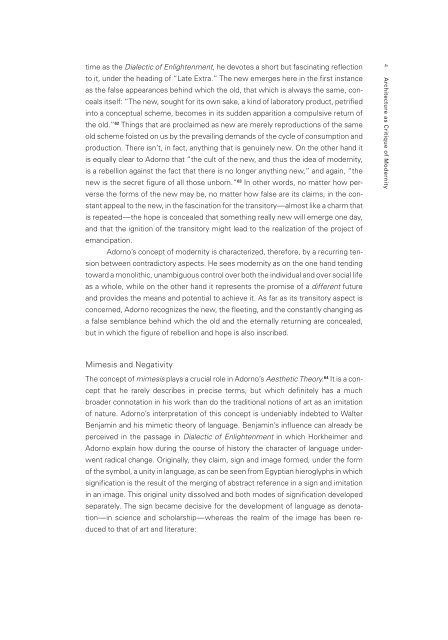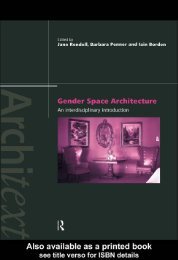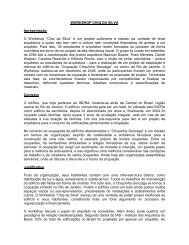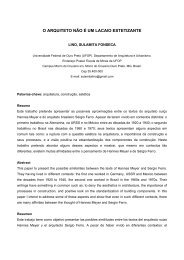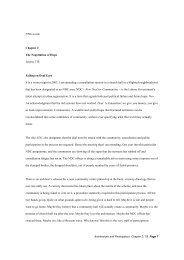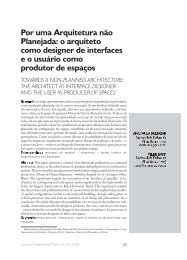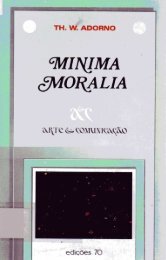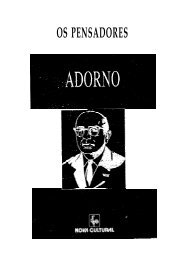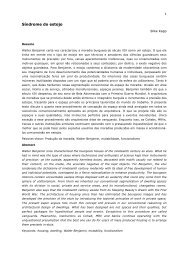Architecture and Modernity : A Critique
Architecture and Modernity : A Critique
Architecture and Modernity : A Critique
You also want an ePaper? Increase the reach of your titles
YUMPU automatically turns print PDFs into web optimized ePapers that Google loves.
time as the Dialectic of Enlightenment, he devotes a short but fascinating reflection<br />
to it, under the heading of “Late Extra.” The new emerges here in the first instance<br />
as the false appearances behind which the old, that which is always the same, conceals<br />
itself: “The new, sought for its own sake, a kind of laboratory product, petrified<br />
into a conceptual scheme, becomes in its sudden apparition a compulsive return of<br />
the old.” 62 Things that are proclaimed as new are merely reproductions of the same<br />
old scheme foisted on us by the prevailing dem<strong>and</strong>s of the cycle of consumption <strong>and</strong><br />
production. There isn’t, in fact, anything that is genuinely new. On the other h<strong>and</strong> it<br />
is equally clear to Adorno that “the cult of the new, <strong>and</strong> thus the idea of modernity,<br />
is a rebellion against the fact that there is no longer anything new,” <strong>and</strong> again, “the<br />
new is the secret figure of all those unborn.” 63 In other words, no matter how perverse<br />
the forms of the new may be, no matter how false are its claims, in the constant<br />
appeal to the new, in the fascination for the transitory—almost like a charm that<br />
is repeated—the hope is concealed that something really new will emerge one day,<br />
<strong>and</strong> that the ignition of the transitory might lead to the realization of the project of<br />
emancipation.<br />
Adorno’s concept of modernity is characterized, therefore, by a recurring tension<br />
between contradictory aspects. He sees modernity as on the one h<strong>and</strong> tending<br />
toward a monolithic, unambiguous control over both the individual <strong>and</strong> over social life<br />
as a whole, while on the other h<strong>and</strong> it represents the promise of a different future<br />
<strong>and</strong> provides the means <strong>and</strong> potential to achieve it. As far as its transitory aspect is<br />
concerned, Adorno recognizes the new, the fleeting, <strong>and</strong> the constantly changing as<br />
a false semblance behind which the old <strong>and</strong> the eternally returning are concealed,<br />
but in which the figure of rebellion <strong>and</strong> hope is also inscribed.<br />
Mimesis <strong>and</strong> Negativity<br />
The concept of mimesis plays a crucial role in Adorno’s Aesthetic Theory. 64 It is a concept<br />
that he rarely describes in precise terms, but which definitely has a much<br />
broader connotation in his work than do the traditional notions of art as an imitation<br />
of nature. Adorno’s interpretation of this concept is undeniably indebted to Walter<br />
Benjamin <strong>and</strong> his mimetic theory of language. Benjamin’s influence can already be<br />
perceived in the passage in Dialectic of Enlightenment in which Horkheimer <strong>and</strong><br />
Adorno explain how during the course of history the character of language underwent<br />
radical change. Originally, they claim, sign <strong>and</strong> image formed, under the form<br />
of the symbol, a unity in language, as can be seen from Egyptian hieroglyphs in which<br />
signification is the result of the merging of abstract reference in a sign <strong>and</strong> imitation<br />
in an image. This original unity dissolved <strong>and</strong> both modes of signification developed<br />
separately. The sign became decisive for the development of language as denotation—in<br />
science <strong>and</strong> scholarship—whereas the realm of the image has been reduced<br />
to that of art <strong>and</strong> literature:<br />
4 <strong>Architecture</strong> as <strong>Critique</strong> of <strong>Modernity</strong>


